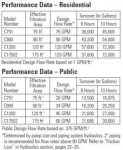We have been running for the past three years with the pump and filter listed in my signature (old Intex 2500 gph pump -- current equivalent model is 633 I believe, and size B filter -- all of 15 square feet). With careful attention to chemistry, this works, for the most part, but is hardly ideal. The pump is now failing, which gives us a chance to upgrade.
I have pretty much settled on a replacement pump -- Pentair Optiflo 347990, which is shown as 1 HP, 2 speed. (here is an Amazon link:
Amazon.com : Pentair 347990 OptiFlo Vertical Discharge Aboveground Pool Pump with 2 Speed Motor and Standard Plug, 1 HP : Swimming Pool Water Pumps : Patio, Lawn Garden). I hope to get the Optiflo pump to finish out this year's season (i.e. hook it up, make sure it runs, etc.). However, I may not be able to upgrade the filter until next year. I would plan to run the pump on low speed, to hopefully not overwhelm our dinky B size filter, during the remaining few weeks of the swim season.
My main question has to do with recommended filter size to go with the Optiflo pump. If I'm looking at the pump curves properly, I think we're looking at about 48 GPM at high speed, and about half of that at low speed for this pump (by the way, how does one decide which of the pump curves -- A, B, or C -- is most appropriate to use?). If I consider a cartridge filter, what is the minimum size that would be sensible with this pump? Do I go by the low speed flow rate (which is what we would be using most of the time for routine filtration, especially with only 5500 gallons) or by the high speed flow rate (since the filter would have to stand up to high speed flow during vacuuming, for example)?
If we go with a sand filter, how big should that be at minimum?
If anyone has any comments with regard to pump choice, I would be happy to hear that as well, of course!
I have pretty much settled on a replacement pump -- Pentair Optiflo 347990, which is shown as 1 HP, 2 speed. (here is an Amazon link:
Amazon.com : Pentair 347990 OptiFlo Vertical Discharge Aboveground Pool Pump with 2 Speed Motor and Standard Plug, 1 HP : Swimming Pool Water Pumps : Patio, Lawn Garden). I hope to get the Optiflo pump to finish out this year's season (i.e. hook it up, make sure it runs, etc.). However, I may not be able to upgrade the filter until next year. I would plan to run the pump on low speed, to hopefully not overwhelm our dinky B size filter, during the remaining few weeks of the swim season.
My main question has to do with recommended filter size to go with the Optiflo pump. If I'm looking at the pump curves properly, I think we're looking at about 48 GPM at high speed, and about half of that at low speed for this pump (by the way, how does one decide which of the pump curves -- A, B, or C -- is most appropriate to use?). If I consider a cartridge filter, what is the minimum size that would be sensible with this pump? Do I go by the low speed flow rate (which is what we would be using most of the time for routine filtration, especially with only 5500 gallons) or by the high speed flow rate (since the filter would have to stand up to high speed flow during vacuuming, for example)?
If we go with a sand filter, how big should that be at minimum?
If anyone has any comments with regard to pump choice, I would be happy to hear that as well, of course!
Last edited:


